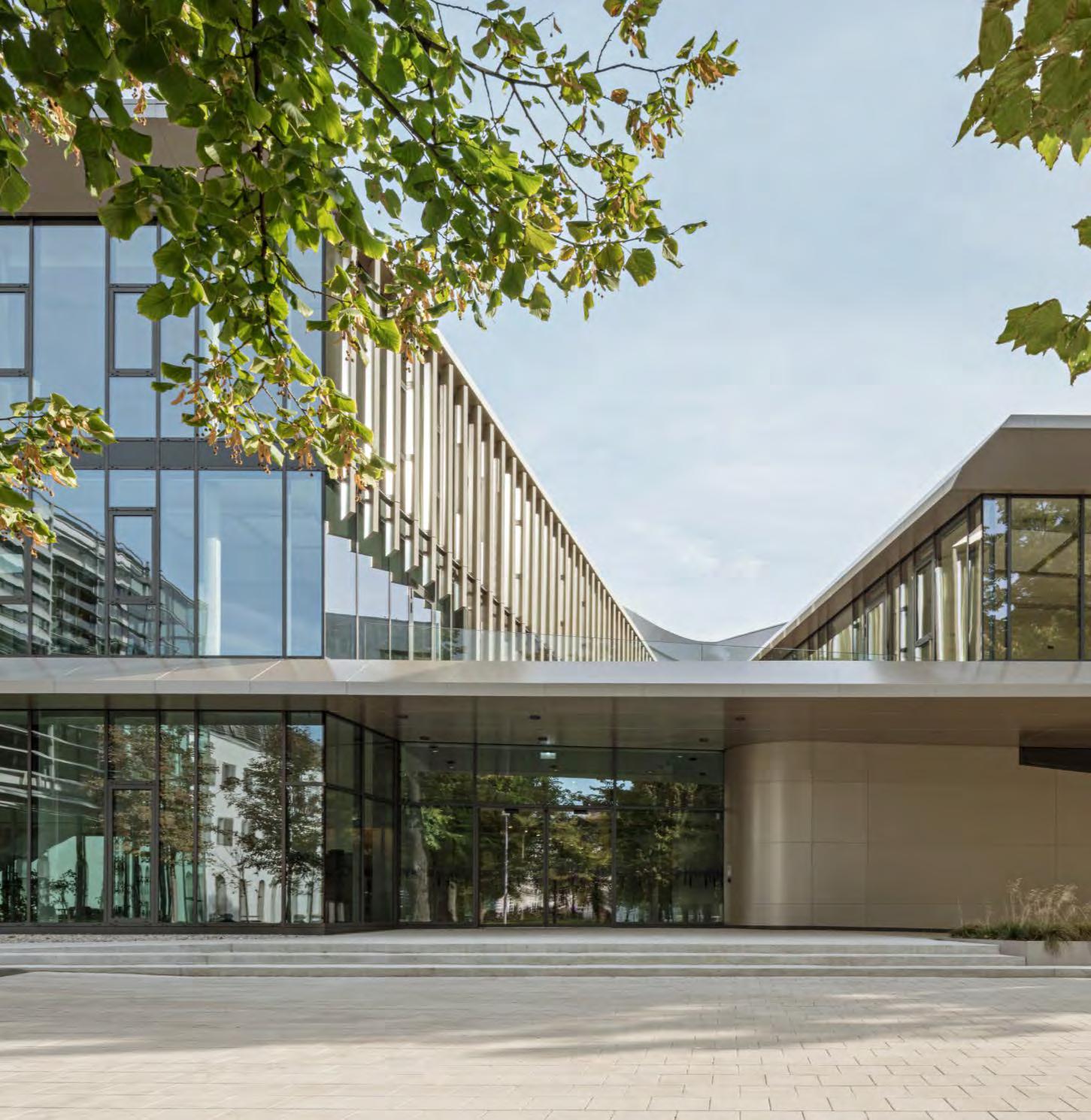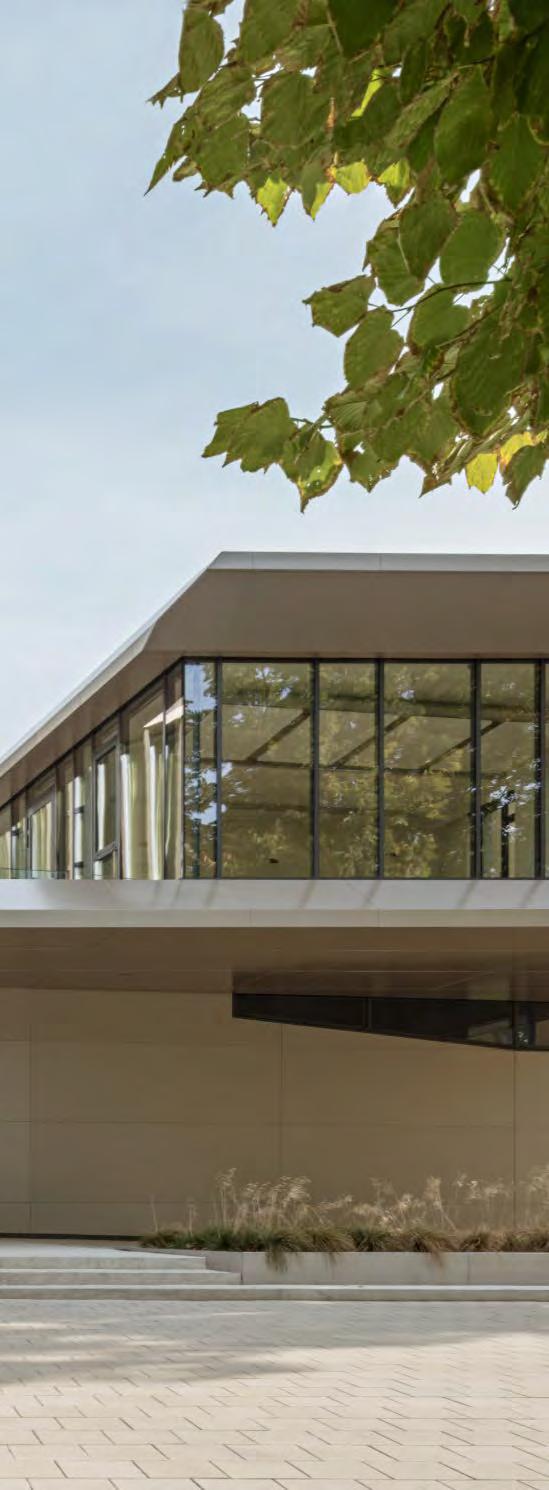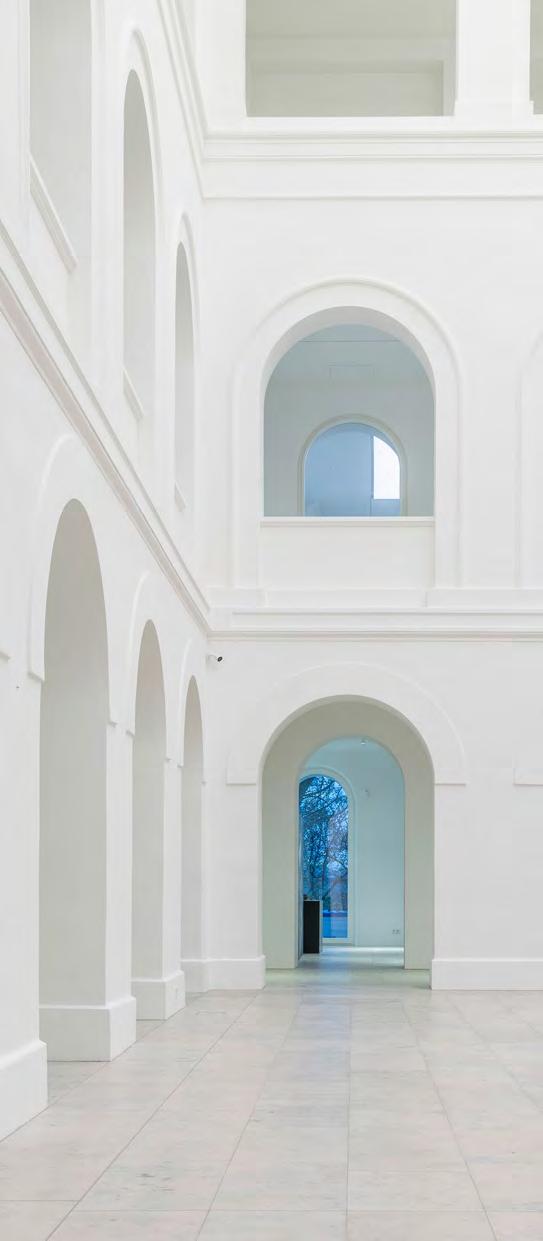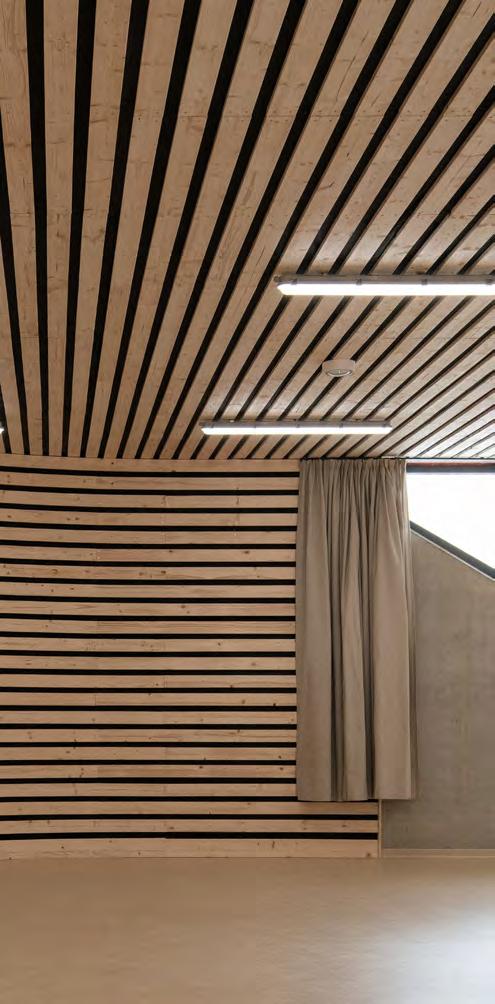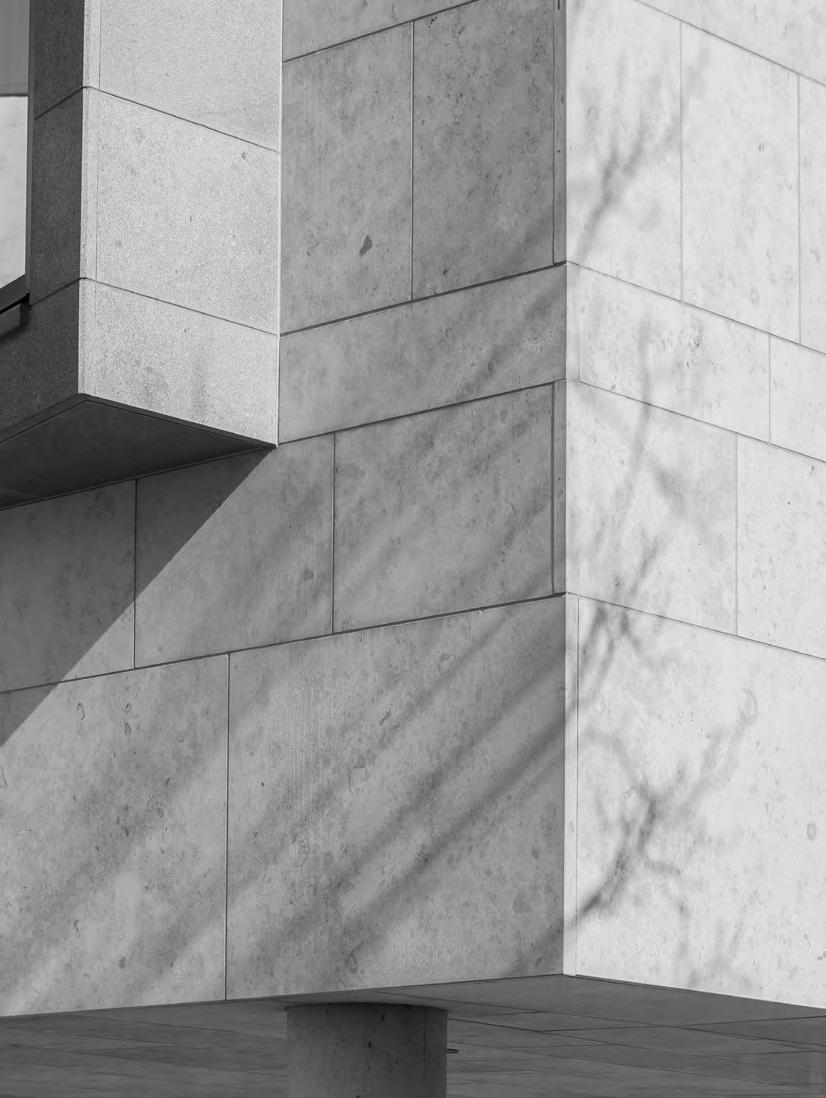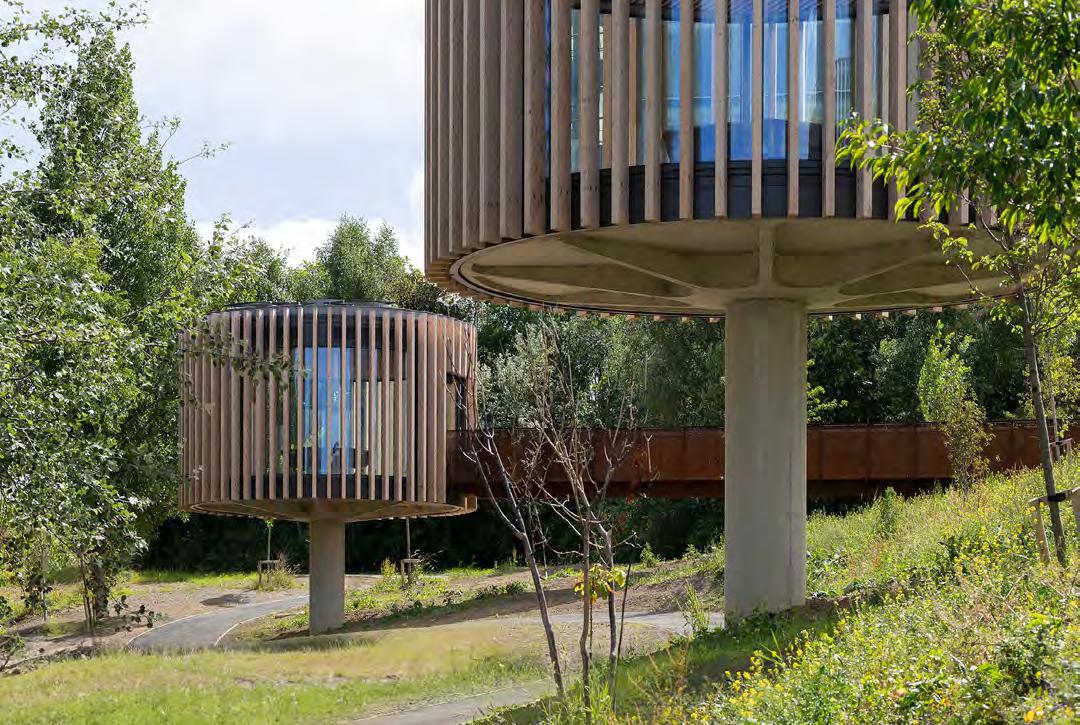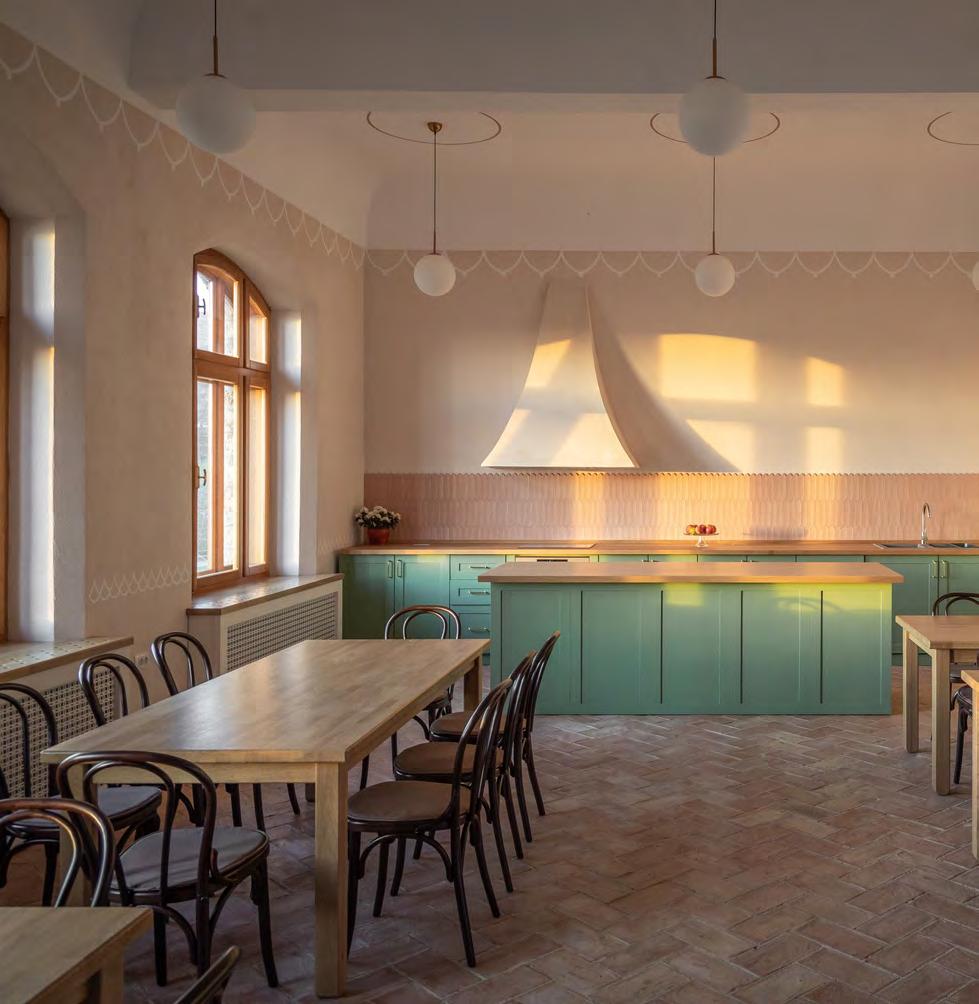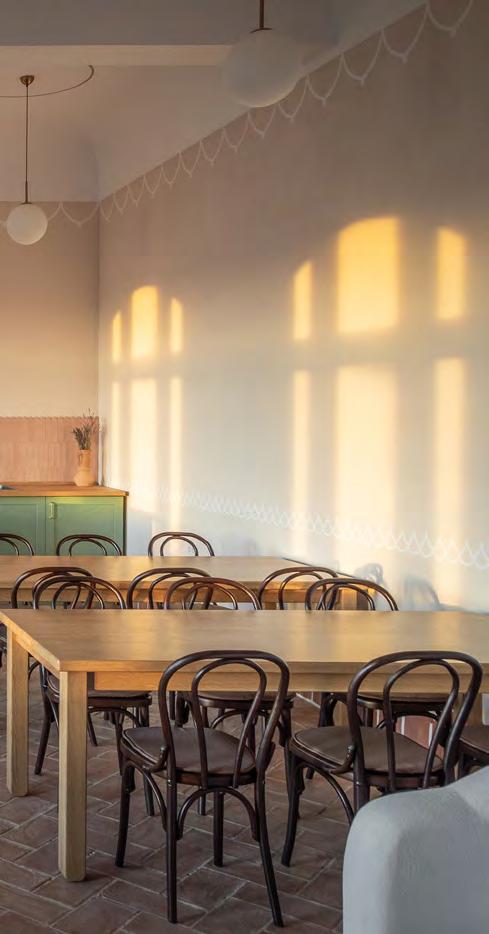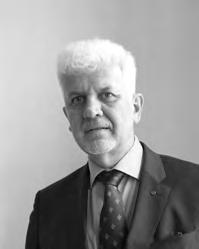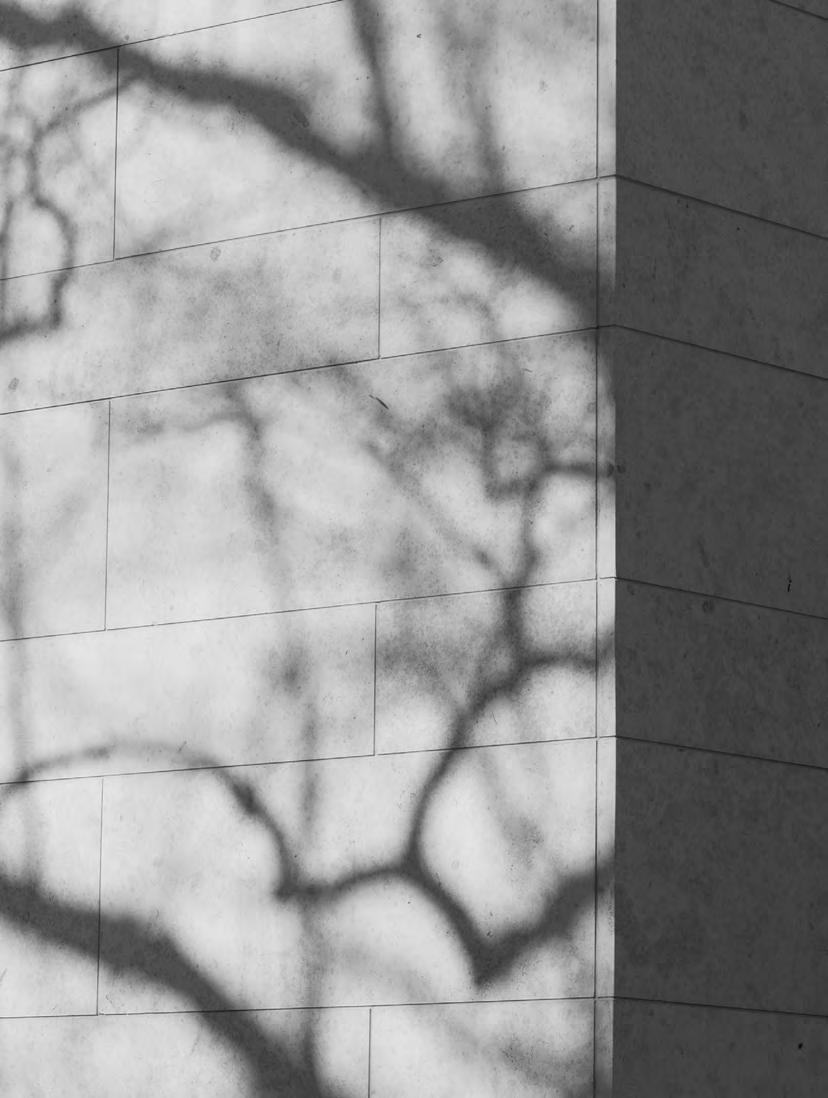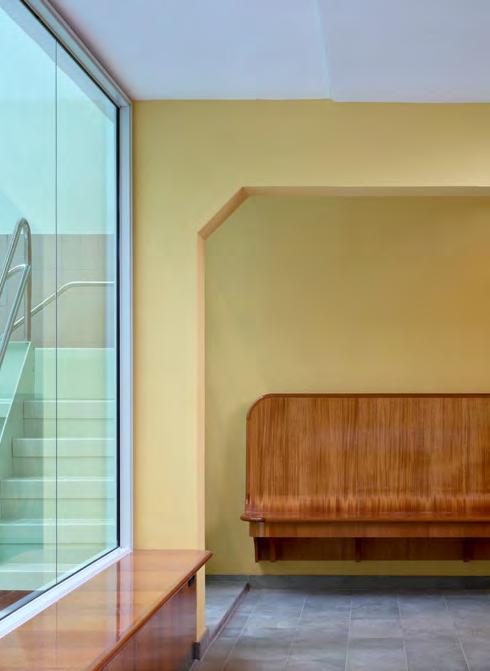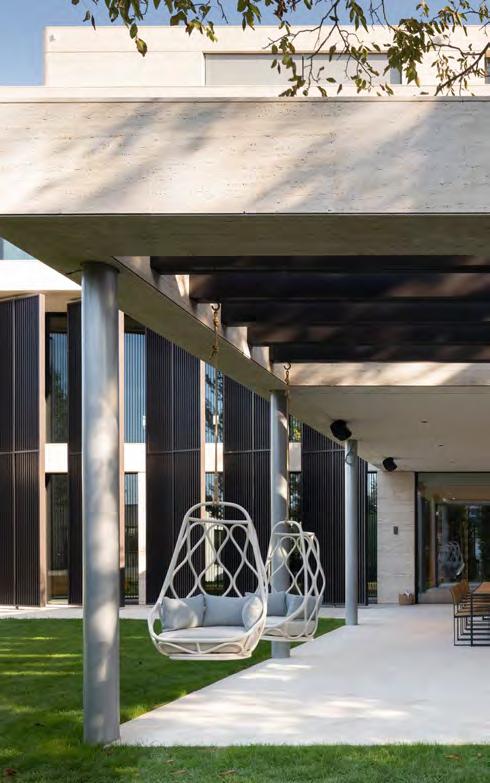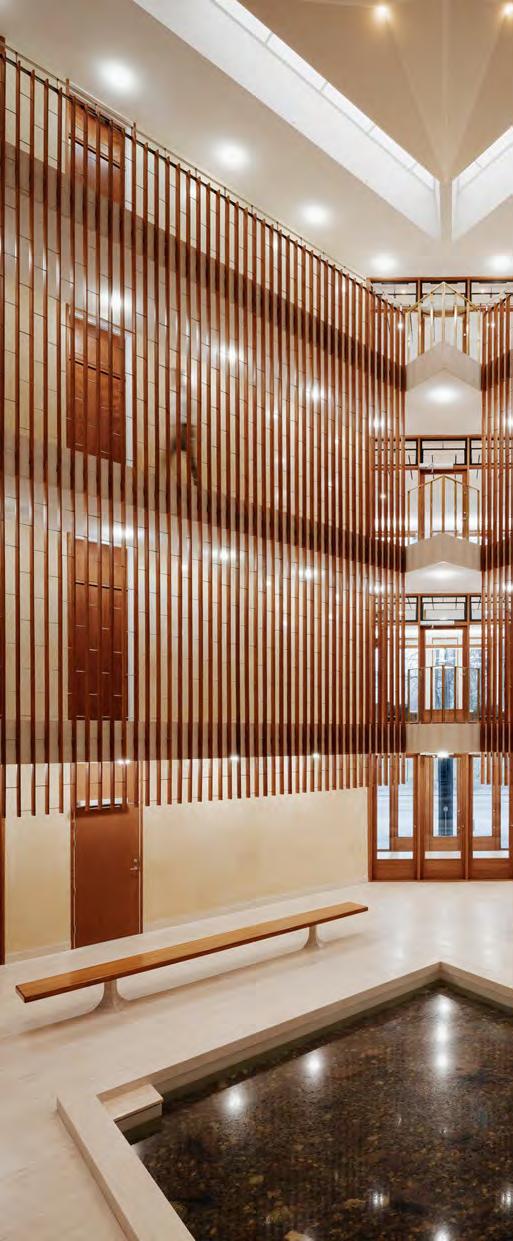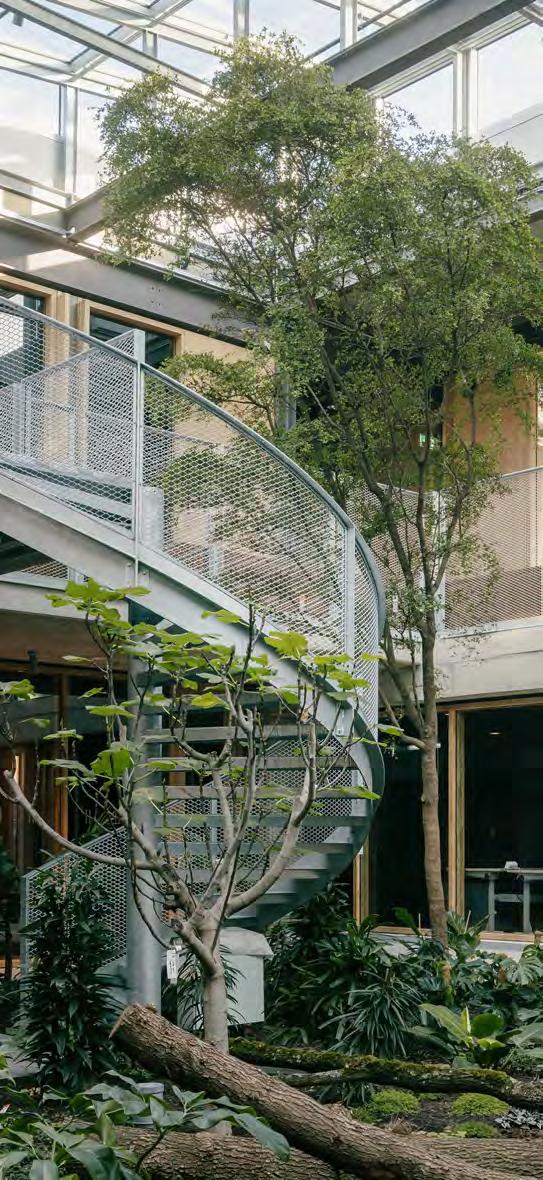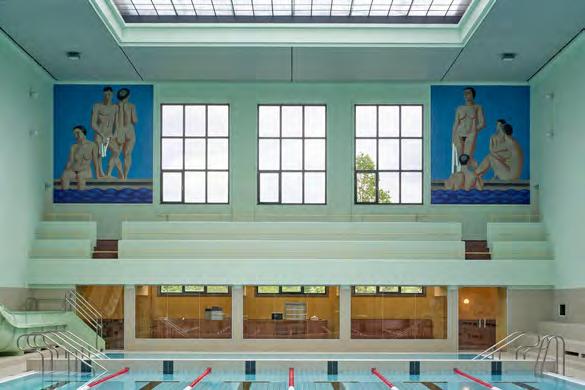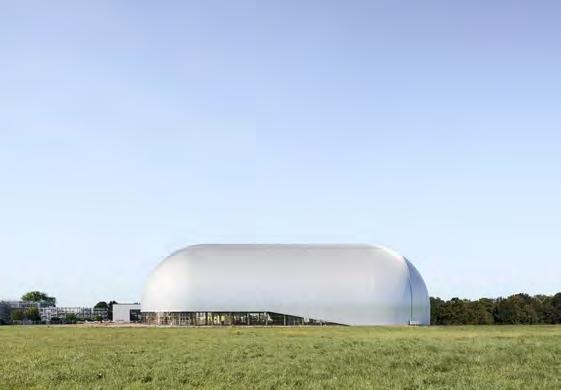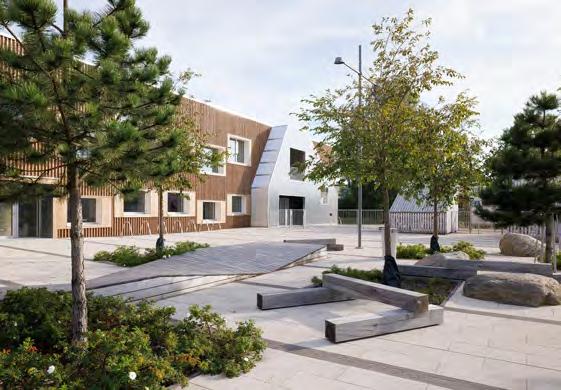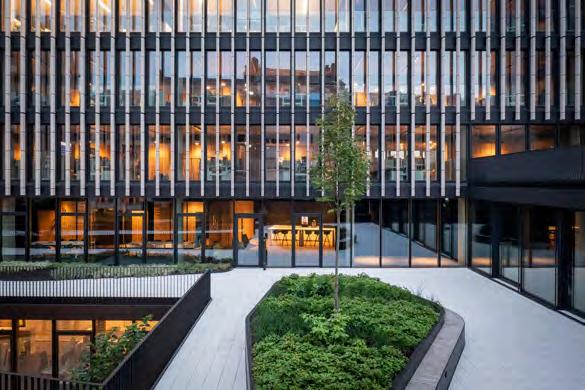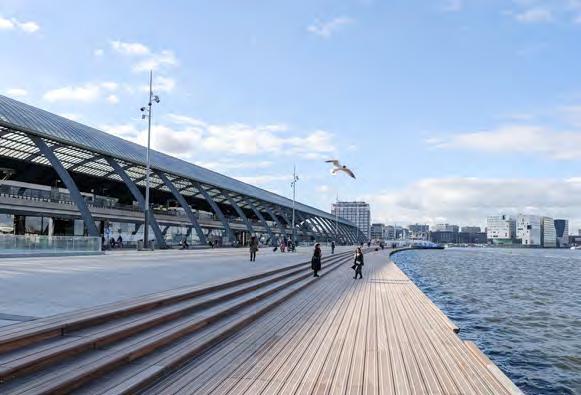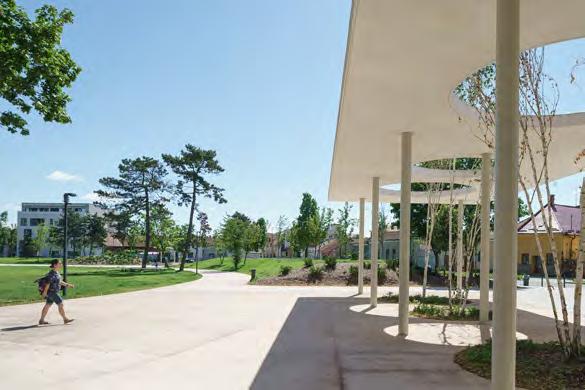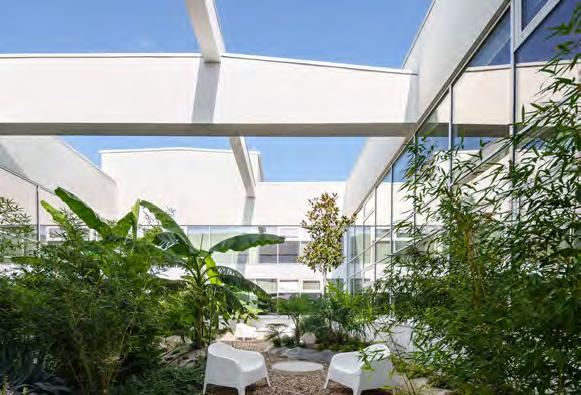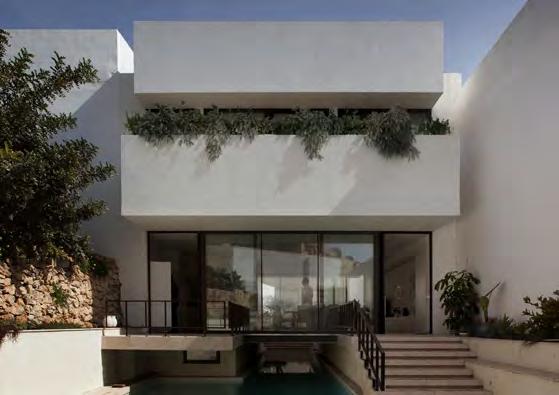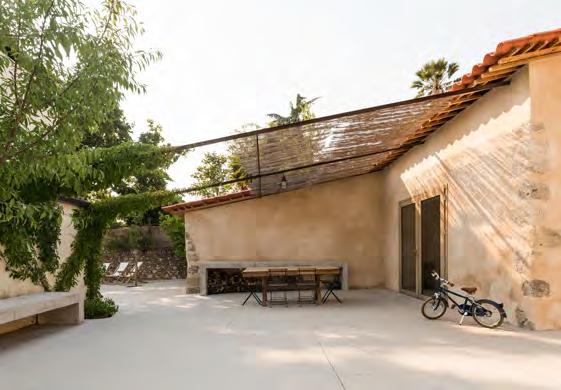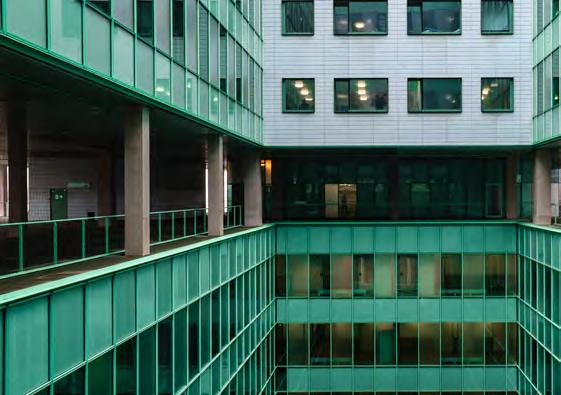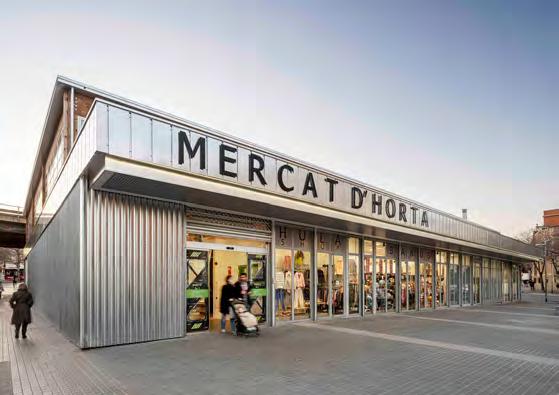Architects’ Council of Europe
Conseil des Architectes d’Europe
Founded in Treviso, Italy, in May 1990, the Architects’ Council of Europe (ACE) is the representative organisation for the architectural profession at European level.
ACE is made up of 52 Member Organisations that are the nationally representative professional associations and / or registration bodies in the EU Member States, the Accession Countries and other European countries with a special status in relation to the EU. Through them, the ACE represents the interests of c. 580.000 architects.
Acknowledgements
ACE acknowledges all who have contributed to our work during the past year and helped us to realise our objectives, in particular ACE Members Organisations and:
2024 Board Members: President: Ruth Schagemann; Vice–President: Carl Bäckstrand; Treasurer: Kornel Kobák; Vice–chair Finance Committee: Andre Pizzuto ; Area Coordinators: Carla Lima Vieira; Diego Zoppi; Borys Czarakcziew; Dubravko Bačić; Think Tank Members: Daniel Fügenschuh, Reto Gmür, Anda Kursiša.
2024 ACE Work Group and Task Force Chairs: Cornelia Hammerschlag; Maria-Dolores Galan; Ian Pritchard; Dubravko Bačić; Ludovica Molo; Katarina o’Cofaigh / Kathrin Rapp; Sergio Garcia-Gascó Lominchar; Pavel Martinek; Peter Hyttel Sørensen; Judit Kimpian / Greta Tresserra; Eugen Pănescu / Corinne Girard Young; Jacques Timmerman, Stefano Musso / Waclaw Szarejko; Selma Harrington; Rūta Leitenaitė; Roberto Rocchi / Alkis Dikaios.
Supported by the ACE Secretariat
Black & White Photos: Myles Shelly
Printing: Booxs
Design: Red&Grey redandgrey.ie
Matthew Farrugia
Architects’ Council of Europe Conseil des Architectes d’Europe
2024 Annual Report & Outlook for 2025
ACE’s Mission is to:
Build consensus on professional matters; demonstrate the contribution of architects to the quality of life and the common good; influence EU legislation impacting on the work of architects.
To this end, ACE applies its Core Value sets, with the aim of being:
__ Democratic, inclusive, member-oriented; Professional, ethical, diverse; Sustainable, resilient, innovative.
ACE’s Vision is to:
Achieve greater recognition of the value of architecture –through engagement, outreach, research and advocacy –the cultural legacy of architecture and its contribution to the quality of life of citizens.
Future Art Lab of the Vienna University of Music and Performing Arts, Austria Architect: Pichler & Traupmann Architekten ZT GmbH
Photo: Hertha Hurnaus
Our mission is to build consensus on professional matters; demonstrate the contribution of architects to the quality of life and the common good; influence EU legislation impacting on the work of architects.
a_c_e–c_a_e. eu
Photo: Marie Luisa Jünger,
Advocacy
Publication of ACE Manifesto for European Parliament elections
Amplification of Manifesto “asks” (one-pagers to assist MOs’ meetings with MEPs)
Meeting with European Parliament’s President, Roberta Metsola
On-going work with the NEB and Davos Alliance
Response to the Commission’s public consultation on the upcoming NEB Facility
Membership of Heritage Alliance Hub (Europa Nostra)
Ambassador of the HouseEurope! initiative
Transposition of EPBD and guidance for MOs
Support for Nature Restoration Law with IFLA
Position on Construction Products Regulation
Development of alliance with sister organisations to advocate for a Planning Services Directive
Follow up on adoption of the MRA with Canada
Submission of recommendation to TCA for a MRA with the UK
Preparation for the next up-date of the Professional Qualifications Directive
Preparation for the next up-date of the Public Procurement Directive
Events
Organised a Conference in Brussels on Internationalisation
Organised NEB Conference on Heritage & Transformation, with Europa Nostra
Adopted the Krakow Declaration
Hosted ACE Energy Day during EU Sustainable Energy Week
Co-organised with CSCAE and COAC the Decarbonising Architecture conference in Barcelona
Co-organised workshop with DGNB at UNEP Buildings & Climate Global Forum, Paris;
Joint declaration with UIA + CNOA FR at UNEP Forum in Paris
Studies & Publications
Conducted survey in preparation for the 2024 edition of the ACE Sector Study
Published “Value Chain Study”
Launched publication on “Organisational structure of firms”
Issued Export Podcast
Final report of Peer Learning Group on Architectural Awards
Issued podcast “An Introduction to BIM”
Workgroups
Took steps to re-form the Practice Committee
Created a new Innovation work group
Created a new Heritage work group
Combined Urban Issues & Housing to form a new work group
Established a Disaster Relief task-force
Provided support for Ukraine task-force
Organisational Development
Finalised NET-ARCH project (2022 – 2024), co-funded by the EU (Creative Europe)
Submitted successful bid to Creative Europe for 2025-2028 programme of funded activity
Launched the new ACE website
Developed the new ACE Strategy for 2025 - 2028
Developed an electronic tool to assist applicants seeking cross-border registration
Soft launch of the ACE HUB mobile app
Expanded membership - Kosovo, Rep. of N Macedonia, Moldova, Montenegro, Serbia, Ukraine
EU–Funded Projects
2 issues of ACE “Key to EU-funded opportunities”
Organisation of a NEB session at Built4People St akeholder forum in Luxembourg
Providing inputs and voting in the topics of Built4People partnership call for 2026-2027.
ACCORD workshop on Digital Building Permits + UN Sustainable Goals at Sustainable Places conference in the framework of ACCORD project
ARV “Architects as facilitators of the energy transition: insights on two Plus Energy Buildings” workshop in Oslo and Palma de Mallorca
NEBULA webinar on NEB education and research with U-RE-HERIT and NEBINAR project s
Establishment of a NEB advisor workgroup as part of NEBULA activities
Contribution to ARCH-e glossary for ADC, SWOT and Architects’ need survey and network
Collaboration with OA Portugal on ARISE e-learning platform in BIM + energy efficiency in buildings
Webinar about the ARISE e-learning platform.
Policy positions on the Impact of +Energy Buildings for policymakers/foster construction of +Energy Buildings (Cultural-e)
Webinar on Digital Building Permits and training materials (ACCORD project).
Represented ACE on ECTP, ECCREDI, IWG5 and Built4People partnership
Participation in NONA, U-RE-HERIT and Caring Nature project as associated partners
Three online webinars “Towards an ACE research policy“.
Participation at Mostar Green Design Biennale
Living Spaces (DG EAC) to help local/regional authorities plan quality architectural policies/projects
8.3k 52 6.919
580K
ACE by Numbers
52 Member Organisations from 36 countries in Europe
Representing the interests of over c. 580.000 architects 15 work groups
Linkedin 6.919 followers
X
@Ace_Cae 2.468 followers in 2024
Facebook
@ArchitectsEU 8.300 followers
YouTube channel
3.900 views and 576 hours watched
In 2024, we gained 138 new subscribers
Designed and launched 1 new website and 1 dedicated cloud platform for ACE members
Implemented 1 mobile app – the ACE HUB app
Strategic Outlook for 2025
Looking ahead, ACE remains dedicated to influencing EU policies, enhancing the competitiveness of architectural practices and strengthening professional mobility. We continue advocating for simple and innovative construction methods to maintain high-quality living environments while supporting knowledge exchange and learning. Our focus areas for 2025 include:
__ Promoting quality-based procurement and architectural design competitions to uphold excellence in the built environment;
__ Advocating for the development of an EU Affordable Housing Plan and furthering engagement in urban policy reforms;
__ Promoting the cultural dimension of architecture and supporting a cultural approach to the living environment;
__ Advocating for a Planning Services Directive;
__ Strengthening digital innovation in architecture through AI, BIM and emerging technologies;
__ Expanding international partnerships and MRAs to support cross-border professional opportunities.
Acknowledgements
I would like to express my deepest gratitude to the ACE Executive Board, our dedicated Member Organisations, the ACE Secretariat and all the professionals and partners who have contributed to our collective success. Together, we continue to shape the future of architecture, ensuring it remains a vital force in building a more sustainable and resilient Europe. With Creative Europe funding secured until 2028, ACE's activities have an additional financial foundation, allowing us to continue our impactful work with confidence.
As we step into 2025, I am confident that ACE will continue to drive positive change and uphold the highest standards in architecture. Thank you for your ongoing support and dedication to our shared mission.
Secretary General’s Report
Ian Pritchard
NET-ARCH programme 2022-2024
(Creative Europe)
This EU-funded programme is designed to:
__ Develop participation in culture (audience development);
__ Build capacity to be active at international level;
__ Advocate for sustainable/environmentally –friendly practices;
__ Promote new technologies to enhance competitiveness;
__ Develop initiatives to optimise networking, upskilling, advocacy, data collection/ dissemination.
We have made every effort to ensure that the outputs of this programme are closely aligned to the ACE Strategy:
Electronic Certificate – Work was completed on the development of an electronic tool designed to assist the submission of documentation to accompany crossborder registration applications. The functionality is being tested by competent authorities in BG, DE, IRL, PL, PT and SK on a trial basis and will be extended once any teething problems have been resolved.
Mutual Recognition Agreements (MRAs) –
The ACE-ROAC recommendation for an EU-Canada MRA was adopted by the relevant CETA Committee and will become fully operational once final approvals have been secured at Provincial, Territorial and Federal levels. ACE also submitted a joint recommendation
with the UK’s Architects’ Registration Board (ARB) under the EU-UK Trade & Cooperation Agreement. Further revisions are expected in 2025 to render the terms of the MRA more symmetrical. Talks have also continued from time to time with colleagues in Mexico and the USA.
Internationalisation – ACE organised a conference on Internationalisation in the Spring of 2024 to illustrate the various sources of assistance available at EU level. ACE also published a Value Chain study, a report on the Organisational Structure of Firms and an Export podcast.
Public Procurement – ACE published its Master Brief & Nine Rules, to optimise the organisation of Architectural Design Contests, a report on Open competitiions vs. restricted competitions and developed good practice procurement guidance for local authorities.
NEB & Heritage – ACE organised a Conference in Krakow: “NEB” Heritage and Transformation”, in collaboration with Europa Nostra.
ACE Sector Study (2024 edition) – Questionnaires were circulated during the year, some 28.000 responses analysed and provisional findings reported to the November Assembly. The definitive study will be published early in 2025.
Accession Countries’ programme – Following the earlier admission to Observer Membership of Serbia, Ukraine and Montenegro, Moldova, the Republic of North Macedonia and Kosovo joined in 2024. There are plans to engage with Albania in 2025. The Secretary General gave a presentation on ACE’s role to members of the Central Europe Free Trade Agreement (CEFTA) and there are plans to organise a briefing day on EU legislation for Western Balkans nations.
Twentyfour, Rabat, Malta Architects: 3DM Architecture
Photo: Matthew Farrugia
The Old School in Tohani, Romania
Architects: ABRUPTARHITECTURA Cristina Constantin, Cosmin Pavel
Photo: Vlad Pătru
2 Professional Issues
Access to the Profession
Practice of the Profession
High Quality Architecture & Built Environment (Baukultur)
Research & Development
Think Tank & Strategic Development
Carla Lima Vieira, Coordinator
Response to European Commission’s survey on the Professional Qualifications Directive
ACE responded to the Commission’s stakeholder consultation on the PQD, which was conducted in preparation for the likely quinquennial review of the Directive in the second quarter of 2025. In particular, ACE gave views on minimum training requirements (advocating, once again, for the international standard of 5 years academic study plus 2 years of practical training). It also took the opportunity to raise the issue of Mixed Qualifications (regarding the treatment of undergraduates who complete part of their training in one Member State and part in another) and to announce plans to introduce a digital tool (accompanying certificate) to assist cross-border registration applications.
Accompanying certificate
By way of voluntary convergence, ENACA and the ACE PQD work group developed this certificate designed to assist Competent Authorities in confirming whether the qualifications of migrants are listed in the Directive. The purpose of such a common form is to reduce user error and make it easier for the host authority to determine whether the applicant should be given automatic recognition, be dealt with under the General System or national law. The tool will be introduced on a voluntary, trial basis by the competent authorities in BG, DE (Baden Württemburg), IRL, PL, PT and SK to eliminate any teething problems.
Proposal for a Planning Services Directive
The timing seems right to advance this proposal in the light of recent initiatives (Davos Declaration, Architecture Policy Conferences, the Baukultur movement, the new Leipzig Charter, the OMC Report, Council Conclusions on High Quality Architecture & Built Environment, the NEB initiative and the new mandate of the European Commission.
In parallel, ACE will advocate for a revision to the Services Directive – so that the quality of the built and natural environment is included as an overriding reason of general interest.
Regulatory issues
ACE responded to various elements of the European Commission’s work programme including an evaluation of the Reform Recommendations on professional regulation (and related infringements); the Regulatory Restrictiveness Indicator; reducing administrative burdens; the Fit for Future Platform; proposals to recognise 3rd country qualifications (Skills & Talent Mobility); a proposal for a Directive on Traineeships and the development of the ACE CPD guidelines and register.
Mutual Recognition Agreements (MRAs)
The completion and adoption of the MRA with Canada constitutes a milestone, it being the first international MRA agreed in the context of a Free Trade Agreement, and gives encouragement to other negotiations with the UK, Mexico, South Korea, Japan and the USA.
Schools – in 2024 ACE agreed to co-fund a Pedagogy Award with the EAAE.
Diego Zoppi, Coordinator
Practice Committee
The statutory objective of the reformed Practice Committee is to promote higher levels of practice in the EU and beyond in line with one of the critical themes of the current ACE Strategy. The Committee’s work aims to address key EU issues such as public procurement, digitalisation, entrepreneurship and internationalisation.
Current objectives include updating the Plan of Work (scope of service) to include green overlay, Level[s], taxonomy; analysing requirements of digital automated processes e.g. building permits, procurement; and up-dating information on national practice legislation, including insurance information
Public Procurement / Architectural Design Competitions
Optimising public procurement is another of ACE’s critical themes. In 2024 the work group published the ACE Master Brief & 9 Rules, issued a paper on Open competitions vs. Restricted competitions and developed good practice guidance for local authorities.
In the coming months, the group will:
Prepare for the next revision of the Public Procurement Directive and advocate ACE’s position, calling for a discrete chapter on intellectual services, better access for SMEs and quality-based approaches (including design competitions);
Support ACE / EU position on the international Government Procurement Agreement;
Continue to support the work of the BKZT to develop a platform for ADCs.
Innovation work group
This group was created in response to the growing importance of digitalisation in architectural practices. Within the ACE framework, digital topics were previously handled by various committees and working groups (Practice Committee, BIM work group). The new group will consolidate these efforts into a unified
approach, acknowledging the increasing impact of advanced technologies, particularly AI, on architectural tools and processes. It aims to:
Develop, together with the BIM WG, a cohesive framework that brings together AI, 3D modeling, BIM, and other emerging technologies in architectural practice;
Explore AI applications: highlight AI’s role as both a creative tool and an analytical tool;
Develop policy positions: facilitate discussions and extract key insights to shape ACE’s policy positions on digitalisation;
Promote technological effectiveness: support architectural practices in adopting innovative tools and workflows to improve design effectiveness and sustainability outcomes.
By addressing these goals, the work group positions itself as a central body for navigating the rapid evolution of digital technologies and their implications for architecture.
Building Information Modelling
The work of this group contributes to promoting higher levels of practice in the EU and also addresses the critical theme of digitalisation. The group monitored the consultation on the impact of BIM in public procurement as well as the work of the CEN TC / 442 committee. In 2024, a BIM podcast was produced comprising five 15-minute episodes based on interviews with users in AT, CZ, DK, and IT, eliciting statements on:
The foundation of BIM (how it is implemented in the public / private sectors);
St andards in ISO / CEN TC 442 – and how they are implemented;
Inter-disciplinary collaboration;
Key challenges – obstacles and benefits; The future of BIM (A.I. and its role in solving technological problems).
Internationalisation & New Business Models
The IBM work group published a study aiming to promote a better understanding of the architects’ role in the Value Chain, underlining the importance of embracing potentially new elements in the Scope of Service . The study lists some 18 activities that can be enhanced in three categories – Sustainability, Digitalisation and Industrialisation. The 5 key roles identified were:
Sustainability building expert;
Social impact and sustainable urban advisor; Green finance expert in sustainability; Low carbon footprint and new technologies / materials consultant;
Circular economic expert for buildings.
The group also published a study on Optimising the Organisational Structure of Firms and developed a series of Export podcasts.
High Quality Architecture & Built Environment (Baukultur)
Borys Czarakcziew, Coordinator
Adoption of the revised Energy Performance of Buildings Directive (EPBD)
Following the formal adoption of the Trilogue agreement by the European Parliament and the Council of the EU in April 2024, the revised Energy Performance of Buildings Directive (EPBD) entered into force on 28 May 2024.
The ACE congratulated the EU institutions for managing to strike a deal before the European elections. This deal paves the way for the implementation of the EPBD by Member States in the year to come. The ACE considers that the revised EPBD is a balanced compromise between the initial positions of the co-legislators. It includes many positive elements that ACE campaigned for, on which the architectural profession can build to both decarbonise the EU building stock and achieve the ambitions of the New European Bauhaus and Davos Baukultur movements, for high-quality living environments.
ACE welcomes the introduction of a requirement for the calculation and limiting of the life-cycle Global Warming Potential (GWP) of new buildings (as of 2028, for all new buildings with a useful floor area larger than 1.000 square metres; and as of 2030, for all new buildings). This is an important first step towards increased consideration of the whole life-cycle performance of buildings and a circular economy. The text brings several other improvements, including Minimum Energy Performance Standards (MEPS), National Building Renovation Plans (NBRP), the Renovation Passport, the rolling out of one-stop shops and greater consideration for indoor environmental quality.
However, the EPBD continues to lack clarity when it comes to comparability and accountability of performance across Member States. While some
quality assurance measures have been introduced there is only a short reference in the text to the need to be able to reconcile calculated performance with as-built and operational data, while the disclosure of operational energy use data remains optional.
Adoption of the revised Construction Products Regulation (CPR)
In 2024, the Council and the Parliament adopted the revised Construction Products Regulation (CPR), which aims to harmonise the EU rules for marketing of those products, facilitate their free movement in the single market, and promote the circular economy and technological development in that sector.
In 2024, Gearoid Carvill (Royal Institute of the Architects of Ireland – RIAI) joined on behalf of ACE a Commission’s Expert Group on Sustainability, which advises the Commission on the production of harmonised standards in relation with the CPR.
Energy Day at the European Sustainable Energy Week (EUSEW)
On 13 June 2024, as part of the European Sustainable Energy Week (EUSEW), ACE hosted a policy seminar on the theme “EPBD implementation through the architectural transformation of living spaces”, with the support of the Creative Europe programme.
Architectural Awards and Prizes are a source of inspiration, demonstrating how the profession can rise to the immense challenges the buildings sector is facing. The event brought together the recent winners of three prestigious Prizes, namely Max HACKE, Winner of the 2024 EUMies Award, Sophie MAURER, for one of the winning projects of the 2024 New European Bauhaus Prizes, and Jose TORAL, Winner of the Construmat Awards 2024.
The session was an opportunity for policy makers, practitioners and the wider public to discuss the barriers and enablers to scaling up design excellence as part of Member State adoption of the New European Bauhaus, Level(s), and the recast Energy Performance of Buildings Directive (EPBD).
Urban and Housing Transformation Work Group
In 2024, the ACE Executive Board decided to combine the Urban Issues Work Group and the Housing Task Force. The new Urban and Housing Transformation Work Group is co-chaired by Corinne Girard-Young (CNOA, France) and Eugen Panescu (OAR, Romania).
While the new EU Commission is expected to develop a first ever European Affordable Housing Plan, the Work Group will aim to develop policy recommendations and will be a platform for ACE Member Organisations to exchange on urban renewal and regeneration; adaptation of cities to climate change; and quality and affordable housing.
The Working Group is currently preparing ACE's position on housing as a result of the work of all Thematic Areas.
In November 2024, the ACE co-signed a letter with the European Housing Forum calling for the re-establishment of the URBAN Intergroup in the European Parliament. The URBAN Intergroup, established in 2005, has been successfully working to ensure that urban-related challenges, including housing, are adequately reflected in the European Parliament’s decisions and has provided a trusted platform for discussing housing matters in the European Parliament.
Heritage Work Group
In 2024, the ACE Executive Board decided to establish a new Work Group to deal with Heritage issues. This new Work Group is co-chaired by Stefano Musso (CNAPPC Italy) and Waclaw Szarejko (IARP Poland). In Europe, 25% of the building stock was built before 1940 and 97% needs to be retrofitted if we are to achieve the 2050 objective of a decarbonised building stock. A significant number of buildings incorporate strong heritage values – whether they are officially listed and protected, or not.
The Work Group will develop recommendations to adapt historic and heritage buildings (including those that should be left as a testimony of our time and the 20th century for future generations) and structures to the requirements of the 21st century and the demands of the New European Bauhaus. It will be a platform for ACE Member Organisations to exchange best practices and discuss the role of the architectural profession in the preservation and transformation of historic buildings.
Conference “New European Bauhaus: Heritage & Transformation”
On 28 November 2024, the ACE and Europa Nostra co-organised in Krakow (Poland) a conference on the theme ‘New European Bauhaus: Heritage & Transformation‘, with the support of the Creative Europe programme and the Europa Nostra Heritage Hub in Krakow.
As the European Union, Member States, regions and cities have embarked on a radical transformation of our built environment, the conference aimed at raising
awareness among policy-makers and stakeholders of the challenges facing our built heritage; sharing good practices and innovative solutions for the protection, retrofit and re-use of our built heritage; and discussing barriers and enablers to scale up these good practices and support innovation.
On this occasion, ACE, Europa Nostra and ICOMOS adopted the Krakow Declaration, which puts forward seven key recommendations for the future of Europe’s built environment and calls upon the EU Institutions and Member States to adopt an holistic, quality-driven and cultural approach in all EU policies and funding programmes which impact upon the built heritage.
Disaster Relief Task Force
Considering recent disasters in Turkey, Croatia, Italy, and Ukraine, the ACE Executive Board decided to establish a Task Force for dealing with issues relating to natural and man-made disasters. The aim of the Task Force is to strengthen knowledge sharing between member organisations, collect and share good/ best practices and create a set of potential recommendations to public authorities, focusing on seven topics: Risk Assessment; Culture of prevention; Emergency Protocols; Role of the Profession; Training of Architects; Quality of Reconstruction and specificities inherent to Heritage. ACE appointed architect Roberto Rocchi as co-leader of the Working Group alongside Alkis Dikaios.
EU-funded Projects
In 2024, two projects concluded while two new ones were initiated. The ARISE and BUSCircular projects successfully delivered tools to upskill professionals in the design and construction industries, focusing on BIM and circular design. These projects developed a task-based qualification framework applicable across any European Member State to support professionals in their upskilling journey. They also produced comprehensive training materials, including the ARISE online platform.
At the start of 2024, two new projects—SONATA and HeriTACE—were launched. SONATA investigates how office spaces can be adapted to different user needs through automated systems for ceilings, partitions, lighting, and glazing. Meanwhile, HeriTACE explores innovative technologies to enhance the energy efficiency of historic buildings while preserving their unique features.
Throughout the year, several activities were undertaken, including webinars, workshops, and both online and in-person events. Highlights included:
The webinar on Education and the New European Bauhaus (NEB) where UREHERIT and Nebinars were presented, part of the NEBULA project;
An NEB session organised by ACE during the Built4People Stakeholder Forum in Luxembourg; Climate-positive circular community events in Norway and Palma as part of the ARV project;
A webinar on training materials focused on Digital Building Permits using BIM as part of the ACCORD project;
Collaboration between the ARISE e-learning platform and the Portuguese Order of Architect.
This year, the ACE team working on EU projects experienced some changes. We bid farewell to Gloria Oddo, wishing her all the best in her new endeavours, and warmly welcomed Marta Candidi to the team.
New European Bauhaus Work Group
Since its launch in 2021, the ACE has enthusiastically embraced and supported the New European Bauhaus at different levels. This has continued in 2024 with multiple actions.
In April 2024, as part of the NEB Festival, the ACE organised in Brussels a one-day conference on the theme “Sharing Common Values: Internationalisation of the architectural profession and the New European Bauhaus”. Beyond business and entrepreneurial perspectives, the conference also provided an opportunity to discuss the relevance of the NEB values, themes and principles for other parts of the world and emphasise the common values that unite the profession across the world.
In 2024, the ACE responded to the Commission’s public consultation on the future NEB Facility, a new funding tool aiming to revitalise neighbourhoods through design for sustainability and inclusion. It builds on and combines different funding instruments of the Commission and covers the full cycle of implementation of solutions – from research and innovation to deployment. The ACE welcomes the launch of the NEB Facility, considering that a dedicated funding instrument is essential to achieve the ambitions of the NEB. It will also be an important mechanism to help bring the public sector closer to the creative professions, which are mostly the initiators of the NEB projects.
In 2024, the ACE contributed to the development of the NEB Checklist, a tool developed by the JRC to support the self-assessment of the alignment with the NEB core values and working principles of small projects or project ideas (total investment costs below EUR 100,000).
In 2024, Jacques Timmerman, Chair of the ACE NEB Work Group, continued to promote the ACE Manifesto on the NEB at several events organised by the EU institutions and stakeholders of the sector. The Manifesto sets out the political action programme for the architectural profession to further ambitions in line with NEB principles and calls on architects to take their place in the NEB movement.
“Solidarity with Ukraine” Task Force
The UREHERIT project made significant progress in preserving Ukraine's architectural heritage. Key accomplishments included delivering reports on heritage value assessment and damage assessment methodologies. The initiative also focused on holistic renovation of Soviet-era housing, engaging Ukrainian communities through Urban Hackathons, organising workshops for communities in Ukraine on sustainable heritage preservation and a professional workshop on architecture design competitions. Educational programmes were enhanced, with the Kharkiv School of Architecture launching a BA programme on cultural heritage reconstruction, and a CPD programme advancing with 12 teams developing pilot projects. The project was highlighted at international conferences and events, including NEB Festival.
In 2025, UREHERIT aims to build on these achievements with webinars on damage assessment, student projects on housing renovation, and an Urban Hackathon on mass housing renovation in Lviv. The participatory process will continue with more hackathons, and a digital tool for Architectural Design Competitions will be developed. The project will be showcased at the conference in Vilnius, April 2025. In February 2025, a second financing application for the term 2026-2028 has been submitted to sustain and expand UREHERIT's efforts.
Future School for Ukraine and NEB Lab "Public Infrastructure for Ukraine"
The "Future School for Ukraine" initiative reached a milestone with the signing of a contract with competition winners. The technical design is due to summer 2025. The results of the initiative were widely presented, including an online event of the NEB LAB “Public infrastructure for Ukraine”. In 2025, the "Future School for Ukraine" initiative will be monitored, and new initiatives and new partnerships incubated in the LAB.
The RECOMMENDATIONS “SAFEGUARDING CULTURAL HERITAGE IN UKRAINE” by the EU Commission’s advisory experts sub-group were finalised and publicly presented during a special event ”Resilience Through Culture: The EU's Support for the Ukrainian Cultural Sector” co-hosted by the EU Commission and the Goethe Institute, in Brussels, in May 2024. In 2025, the recommendations will be constantly updated and consultations to EC and Ukrainian society delivered by the experts' group.
Living Spaces
In 2024, the ACE completed the Living Spaces project, a peer-learning programme designed for local and regional authorities to learn how to plan and implement high-quality architectural policies and projects.
Funded by the Creative Europe programme, Living Spaces was implemented by the ACE and Eurocities from July 2023 to December 2024.
In 2024, the ACE and Eurocities organised 12 on-site peer learning visits for groups of 20 people (civil servants in EU’s cities, regions, and Member States as well as relevant stakeholders).
Daniel Fügenschuh, Reto Gmür, Anda Kursiša
Strategic Development
During 2024 the ACE Executive Board and staff participated in a facilitated Strategic Development Session to review of outgoing strategy and prepare a new one for the period 2025-2029.
The session set out to:
Evaluate ACE’s recent activity and achievements, in a changing strategic landscape; Develop a new 5-year strategy and reach agreement on strategic objectives and critical themes;
Consider implications for our operating environment, implementation and communication; Build shared clarity, confidence and commitment to the way forward.
The usual methodology was employed – Contextual review (external / internal environments) ; historical scan to reflect on accomplishments / milestones / lessons to be learned; confirmation of Core Values, Mission; Vision; SWOT analysis; “Blue skies” thinking to consider our preferred future; mapping of Critical Themes and identification of tactical objectives.
The Mission was agreed : to build consensus on professional matters; demonstrate the contribution of architects to the quality of life and the common good; influence EU legislation impacting on the work of architects.
The Vision was confirmed : to achieve greater recognition of the value of architecture – through engagement, outreach, research and advocacy – the cultural legacy of architecture and its contribution to the quality of life of citizens.
To better understand forthcoming opportunities and the strengths we might deploy to realise our Vision, as well as any weaknesses and threats that may stand in its way, we carried out a SWOT analysis. We also identified six things we would like to have achieved within the next 5 years: - Successful advocacy; Political influence; Sustainability by default; Quality services for the common good; Impactful engagement and a Strong, efficient organisation.
We considered the results of a Pecha Kucha conducted in the General Assembly to be sure to reflect the needs and wishes of our Member Organisations. Priorities included:
(a) Green Deal, Renovation Wave, Climate Crisis, EPBD, Energy Efficiency;
(b) Regulation (incl. advocacy for a Planning Services Directive);
(c) Practice, Scope of Service, inter-disciplinarity, Health; Safety, Value Chain, fees;
(d) Public Procurement;
(e) Education,future competences, PQD, Life-long learning, mobility, international;
(f) NEB;
(g) Value of Architecture / Quality ;
(h) Innovation (digitalisation, artificial intelligence, Open BIM);
(i) Housing / affordable housing;
(j) Cultural Heritage; and
(k) Ukraine / Palestine.
We also had regard for the items for which we advocated in the ACE Manifesto for the 2024 European Parliament elections which included: (i) Value of Architecture; (ii) Affordable Housing; (iii) NEB Values; (iv) a proposal for a Planning Services Directive; (v) alignment of the PQD with the international standard of education and training (5+2); (vi) achieving automatic recognition for holders of Mixed Qualifications; (vii) strict reciprocal application of the GPA and support for the international procurement instrument; (viii) research funding for Start Ups; (ix) support for a SME Relief Package; (x) consideration of the Whole-life impact of the Built Environment, Circular Economy in the Construction Industry; (xi) advocating renovation rather than newbuild along with Passive / Nature-based solutions.
Last we considered some of the deliverables to which we are committed in the framework of our latest EU-funded Creative Europe programme, which are intended to address the following aims:
Empowering the cultural industries;
Culture for the People;
Culture for the Planet;
Culture for the co-creative partners;
Culture for digital transformation.
This programme enables us to organise events, forums and conferences, commission studies and research to underpin policy positions, curate exhibitions to sensitise the public to the work of architects and generally to collect and disseminate data and knowledge.
We then began to blend the needs / wishes of the Member Organisations with the “asks” of the Manifesto, within the context of the Creative Europe programmes and distilled 7 Critical Themes:
__ Sustainability – NEB, promoting renovation, social, EPBD;
__ Value of Architecture – housing, heritage, value chain;
__ Quality of services – ADCs, Procurement, Scope of Service;
__ Education / Upskilling – CPD and Professional Qualifications;
__ Regulation – reducing the regulatory burden, advocate for a Planning Services Directive;
__ Internationalisation – EU/International crossborder exchange;
__ Innovation – A.I., Digitalisation.
Finally, we developed lists of over 40 tactical objectives to be pursued in furtherance of each of the 7 Critical Themes, spread over the four years of the strategy.
In parallel, we will develop a programme to improve the internal operating environment which would cover – HR; upskilling of staff; a Cloud network for organising / communicating with work groups; up-dating digital tools – e.g. Teams; improved financial resources; use of consultancy; optimisation of internal task division and cyber–security.
To ensure the vision is well understood and shared, Communication and monitoring will be vital. We must guard against failing to cease activities (only adding amounts to “Mission Creep”); insufficient measurement of performance, auditing, testing, feedback; nonalignment of resources; lack of contingency / flexibility to deal with externalities; slow decision-making and imprecisions in the strategy.
The Executive Board will regularly monitor progress, through the business plan, ensuring the objectives are S-M-A-R-T (Specific-Measurable-AchievableRealistic-Time-related) and critical success factors are identified. A Communications strategy has been developed to promote and explain the Strategy and enliven the vision.
Corte Renèe, Oliosi (VR), Italy Architects: Bricolo Falsarella associati
Photo: Pietro Savorelli
Communications
Strategic alliances and networks
2025 Political context
ACE Website
ace–cae.eu
Social Media
Linkedin – Architects’ Council of Europe (ACE–CAE)
X @Ace_Cae
Facebook @ArchitectsEU
Instagram @ace.archi.eu
YouTube – Architects’ Council of Europe (ACE–CAE)
Strategic Thinking: Shaping the communications approach for ACE Advocacy
A strategic initiative has been launched by Andre Pizzuto, ACE Executive Board Member with the support of J Deutschmann to refine the communications approach for ACE’s advocacy campaigns. This process includes an analysis of the ACE Manifesto campaign during the EU elections, mapping the target audience and defining key strategies using a policy matrix. A strategy timeline is also being developed, integrating both EU-level plans and national highlights. Ongoing work includes: conducting an internal study to better understand the needs, priorities and resources of Member Organisations, analysing past campaigns, exploring ways to maximise the value of ACE’s expertise and experts, while addressing the need to invest more in communications. This strategic rethink aims to create a more impactful, resource-efficient, and scalable approach to ACE’s advocacy and communications efforts.
Campus Universitario de Vigo, Spain
Architects: Benedetta Tagliabue – EMBT
Architects
Photo: Milena Villalba
Manifesto Campaign: Time to Act
Ahead of the European Elections, the Architects’ Council of Europe launched the Time to Act online Manifesto campaign, urging MEPs to prioritise highquality architecture and living environments for all.
To support advocacy efforts, Red&Grey developed a comprehensive Manifesto Kit, which included:
The ACE Manifesto in PDF format (available in English and French);
A promotional video for use on social media platforms;
Campaign visuals designed to enhance advocacy efforts across the ACE network.
ACE also encouraged communication activation among its members and extended network, amplifying the campaign’s reach and impact.
ACE Social Media Campaign: Time to Act
As part of the EU elections initiative, ACE created an Instagram account and launched a creative competition for its community. Participants were invited to submit photos of their city, town, or country that aligned with the values and objectives of the ACE Manifesto. The winning photos were prominently featured, connecting the Manifesto’s vision with tangible examples from across Europe.
Launch of the New ACE Website
In December 2024, the ACE unveiled its new website, marking a significant milestone in the organisation’s digital transformation. The redesigned platform fully integrates the updated ACE visual identity, delivering a cohesive and modern user experience.
The new website was developed to achieve key objectives, including:
Enhancing search functionality to make information more accessible;
Revamping the design and user experience for improved engagement;
Optimising information architecture for better content organisation;
Streamlining navigation for ease of use;
Promoting inclusivity by incorporating multilingual capabilities.
This launch demonstrates ACE's commitment to accessibility, innovation and providing a seamless digital experience for its diverse audience.
The website now includes an all-new members’ section – the ACE Cloud – designed to provide an improved communication and collaborative workspace for ACE workgroup members and delegates.
The website has been developed by PENROSE and integrates the eTranslation tool, the cutting-edge neural machine translation service provided by the European Commission.
New ACE mobile app
2024 was also the year in which we developed the ACE HUB, the official ‘app’ from the Architects’ Council of Europe (ACE), designed specifically for architects across Europe. The ACE HUB is the go-to platform for professional networking, knowledge sharing and keeping up-to-date with the latest architectural events. It is a one-stop-shop that connects architects from across Europe in a dynamic and seamless way.
Key Features of ACE HUB:
__ Professional Matchmaking: based on user-specific criteria such as skills, expertise, location, and interests, the ‘app’ helps you connect with likeminded peers and collaborators across Europe. Whether you’re looking to join forces on a project, share knowledge or expand your professional circle, the ACE HUB can simplify the process;
__ Peer-to-Peer Communication: stay connected with the architectural community through the ‘app’s’ direct communication features. Share ideas, discuss trends and exchange knowledge with fellow architects, all in one place;
__ Cultural and Event Information: the ACE HUB keeps you informed about all the upcoming architectural events—be it ACE-hosted events, members’ and partners’ lectures, workshops, and exhibitions.
The ACE HUB has received the support of the Creative Europe programme of the European Union.
Frederiksberg Swimming Hall, Denmark
Architects: Cornelius Vöge ApS
Photo: Adam Mørk
Strategic Alliances & Networks
ACE has developed relationships with other networks to strengthen the voice of the profession in the EU.
AIA - American Institute of Architects
Barbara Cappochin Prize
B4P – Built4People
CEN – European Committee for Standardisation
CPEA – Climate Positive Europe Alliance
Davos Baukultur Alliance
DG EAC Expert Group on Cultural Heritage
DG GROW High Level Construction Forum
EAAE - European Association for Architectural Education
EBSA – European Business Services Alliance
ECCE – European Council of Civil Engineers
ECCREDI – European Council for Construction, Research, Development & Innovation
ECEC – European Council of Engineering Chambers
ECIA – European Council of Interior Architects
ECTP – European Construction Technology Platform
ECTP - European Council of Town Planners
EESC - European Economic & Social CommitteeLiaison Group
EFCA – European Federation of Engineering Consultancy Associations
EHA - European Heritage Alliance
EHF - European Housing Forum
ENACA - European Network for Architectural Competent Authorities
ESF – European Services Forum
Europa Nostra
FAIB – Fédération des Associations Internationales en Belgique
Villa TLS, Belgrade, Serbia
Architect: Predrag Milutinović
Photo: Relja Ivanić
FCARM – Federacion de los Colegios de Arquitectura
de la Republica Mexicana
Global ABC – Global Alliance for Buildings & Construction
IFLA Europe – International Federation of Landscape Architects (Europe)
HouseEurope!
Housing Europe
NCARB – National Council of Architectural Registration Boards (USA)
NEBC – New European Bauhaus Collective
NEB Lab – Regulatory Analysis & Experimentation
NEB in Bosnia + Herzegovina (Sarajevo)
NEBINAR
KIRA – Korean Institute of Registered Architects
UIA – International Union of Architects
WGBC – World Green Building Council (#BuildingLife)
European Council - Strategic Agenda 2024-2029
In June 2024, the European Council agreed on the Strategic Agenda 2024-2029, which sets the EU’s priorities and its strategic orientations. It is structured around three pillars:
__ A free and democratic Europe. The priorities within this area include, among others: promoting and safeguarding the rule of law; strengthening democratic resilience and debate; ensuring that tech giants take responsibility for safeguarding democratic debates online.
__ A strong and secure Europe. In this area, the Council’s priorities will be: continued support for Ukraine, including its reconstruction and the pursuit of a just peace; a merit-based EU enlargement process with incentives, to run in parallel with necessary internal reforms.
__ A prosperous and competitive Europe. The EU’s priorities in this area include: a deeper single market; an ambitious, robust, open and sustainable trade policy; the green and digital transitions; investment in skills, training and education; the promotion of an environment conducive to innovation and business.
Read the Strategic Agenda 2024-2029
Council of the EU – Trio Programme
From January to July 2025, Poland will assume the Presidency of the Council of the European Union. It will form, together with Denmark and Cyprus, the so-called Trio of Presidencies, whose programme is organised around the following themes:
__ A Strong and Secure Europe, which refers to external actions, security and defence, migration and border protection, enlargement and internal reforms.
__ A Prosperous and Competitive Europe, which deals with various components that make up competitiveness, twin transition, innovation, environment and social affairs.
__ A Free and Democratic Europe, which contains references to EU values such as rule of law and human rights.
Read the Trio Programme
European Commission – Political Guidelines for 2024-2025
On 1 December 2024, the new College of Commissioners, headed by Ursula von der Leyen, took office, after hearings by the European Parliament. Under the motto “Europe’s choice”, the guidelines emphasise the European Union's choice to unite its societies and values, to ensure democratic values, to face new realities, and to be bold and ambitious. They outline the EU's priorities together with ideas and proposals on how to achieve them.
In 2025, the ACE will closely follow up the development of the following initiatives, announced in the Mission Letters sent by U. von der Leyen to Commissioners-Designate: Development of a horizontal Single Market Strategy; Development of a European Affordable Housing Plan and European Strategy for Housing Construction; Development of a Circular Economy Act; Further development of the New European Bauhaus initiative; Development of a European Climate Adaptation Plan; Development of a new Culture Compass, an overarching strategic framework to guide and harness the multiple dimensions of culture; Development of an AI strategy for cultural and creative industries; Development of a Skills Portability Initiative.
Read the Ursula von der Leyen’s Political Guidelines for the next Commission
ACE Governance
The Architects' Council of Europe is an International Not-for-Profit Association. It is composed of a General Assembly, an Executive Board and a permanent Secretariat based in Brussels. The General Assembly is composed of a delegation from each Member Organisation.
It is the supreme body and meets twice a year to formulate and adopt the ACE policies and budget. The function of the Executive Board is to execute the policies established by the General Assembly and to ensure the proper administration of the ACE. It is composed of 11 members.
The primary function of the ACE Secretariat is to support the structure of the ACE governance and to be the permanent interlocutor with the European Institutions for the representation of the interests of the ACE.
ACE Secretariat
Ian Pritchard
Secretary General
Lukas Bollaert
Policy & Administrative Assistant
Marta Candidi
EU-funded Projects Officer (from December 2024)
Larissa de Rosso
EU-funded Projects Officer
Julie Deutschmann
Head of Communications
Pierre Obajtek
Senior Policy Officer
Gloria Oddo
EU-funded Projects Officer (until November)
Cat alina Olteanu
Office Manager
Swapna Saha
Assistant EU-funded Projects Officer
Executive Board Members 2023–2024
Ruth Schagemann
President
Carl Bäckstrand Vice-President
Dubravko Bačić
Coordinator, Research & Development
Borys Czarakcziew
Coordinator, Achieving Quality in Architecture/ Baukultur
Daniel Fügenschuh Member of the ACE Think Tank Reto Gmür Member of the ACE Think Tank
Kornel Kobák
Treasurer
Anda Kursiša Member of the ACE Think Tank
Carla Lima Vieira Coordinator, Access to the Profession
Andre Pizzuto Vice-chair, Finance Committee
Diego Zoppi Coordinator, Practice of the Profession
Photo: Stijn Bollaert
Advocacy
__ Continue to advocate for an ambitious and optimal implementation of EPBD
__ Advance proposal for a Planning Services Directive
__ Quality of the built environment as an overriding reason of general interest (SIM Directive)
__ Advance ACE policy positions on Professional Qualifications Directive
__ Advance ACE policy positions on Public Procurement Directive
__ Support reciprocal application of the GPA and use of International Procurement Instrument
__ Promote consideration of the whole life impact of the built environment (circular economy)
__ Advance ACE position on Affordable and Quality Housing
__ Contribute to the development of the Commission’s upcoming Culture Compass
__ Contribute to the Commission’s upcoming AI strategy for cultural and creative industries
__ Continue to support the development of the New European Bauhaus
__ Support the EU Citizens Initiative launched by HouseEurope!
__ Respond to the EU Competitiveness agenda (Letta / Draghi reports)
__ Pursue UK MRA through the TCA
2025
Events
__ Organise Conference with the engineers in Luxembourg in May
__ Organise first edition of the Annual Practice Forum
__ Organise a public conference on the renovation of housing blocks (Prague, Autumn 2025)
__ Launch the new ACE exhibition at the European Parliament on the renovation of the EU building stock
__ Organise a workshop in the European Parliament to sensitise recently elected MEPs to ACE priorities
Studies/Publications
__ Up-date Scope of Service (plan of work)
__ Publish new Sector Study (2024 edition in February 2025)
__ Up-date ACE Observatory
__ Prepare for Practice Survey (structure, questionnaire) Prepare for Access to the Profession survey (structure, questionnaire)
Organisational development
Briefing session for new Observers from Accession countries
__ Initiatiate work on the new Creative Europe Networks programme
__ Conclude the NET-ARCH project, co-funded by the Creative Europe programme
__ Organise two Presidents’ Round Tables
__ Optimise the new ACE website and develop the V2 of the ACE HUB mobile app
__ Monitor trial phase of Electronic Tool (accompanying certificate)
__ Develop new Advocacy & Communications Strategy
Workgroups
__ Provide support for new workgroups (Practice, Innovation, Urban & Housing transformation, Heritage, Disaster Relief)
__ Develop position on use of BIM in Public Procurement, Building Permits
EU–Funded Projects
Draft ACE research policy and inventory of ACE participation in EU funded projects
__ Prepare new issues of ACE “Key to EU-funded opportunities” newsletter
__ Develop ACE participation in proposals
__ SONATA workshop on recommendation for adaptive technologies in workspaces
__ Second webinar on Digital Building Permits, plus training materials (ACCORD) project
Final event of Cultural-e project (policy recommendation for Plus Energy Buildings)
__ Involve NEB advisors’ community in the final event of NEBULA project in Brussels
__ Contribute to Cultural-e webinar on Plus Energy Buildings Hub
ACCORD final conference in Brussels on Digital Building Permits
__ ACE speakers at CiD events in Barcelona, Genova, and Tallin
__ “Architects as facilitators of the energy transition: insights on 2Plus Energy Buildings” (DK, CZ)
ARCH-e final conference in Brussels
__ Webinar about renovation and heritage (HeriTACE project)
Represent ACE at ECTP, ECCREDI, IWG5 and Built4People partnership
__ Develop ACE participation in proposals after approval from ACE members
__ Participate in NONA, U-RE-HERIT and Caring Nature project as associated partners
Expansion of the Child & Adolescent Psychiatry - State Hospital Graz II South, Austria
Architects: NOW Architektur & Architekt DI Reinhold Tinchon
Photo: Emilian Hinteregger
Extension du service de psychiatrie de l'enfant et de l'adolescent - Hôpital d'État Graz II Sud, Autriche
Architectes : NOW Architektur & Architekt DI Reinhold Tinchon
Photo : Emilian Hinteregger
Sports Hall, Řevnice, Czechia
Architect: Grido architects
Photo: Alex Shoots Buildings
Gymnase, Řevnice, Tchéquie
Architectes : Grido architects
Photo : Alex Shoots Buildings
Frederiksberg Swimming Hall, Denmark
Architect: Cornelius Vöge ApS
Photo: Adam Mørk
Piscine de Frederiksberg, Danemark
Architectes : Cornelius Vöge ApS
Photo : Adam Mørk
Ambassaden/the Embassy, Oslo, Norway
Architects: Lundhagem and Atelier Oslo
Photo: Einar Aslaksen
Ambassaden/l'Ambassade, Oslo, Norvège
Architectes : Lundhagem and Atelier Oslo
Photo : Einar Aslaksen
Hyytiälä Forest Station, Finland
Architects: Architects Rundako & Kankkunen
Photo: Martin Sommerschield/Kuvio
Station forestière de Hyytiälä, Finlande
Architectes : Architects Rundako & Kankkunen
Photo : Martin Sommerschield/Kuvio
Airship Hangar Mülheim a.d. Ruhr, Germany
Architects: Smyk Fischer Architekten
Photo: Annika Feuss
Hangar à avions Mülheim a.d. Ruhr, Allemagne
Architectes : Smyk Fischer Architekten
Photo : Annika Feuss
Kinsale Library, Ireland
Architects: Cork County Council Architects’ Department
Photo: Jed Niezgoda
Bibliothèque de Kinsale, Irlande
Architecte : Conseil du comté de Cork, Service de l’Architecture
Photo : Jed Niezgoda
Kindergarten, Salaspils, Latvia
Architects: MADE arhitekti
Photo: Ansis Starks
Ecole maternelle, Salaspils, Lettonie
Architectes : MADE arhitekti
Photo : Ansis Starks
POST Headquarters, Luxembourg City, Luxembourg
Architects: Helix, Metaform, INCA Ingénieurs Conseils
Associés sarl, Goblet Lavandier & Associés Ingénieursconseils, T6 - Ney & Partners
Photo: Steve Troes Fotodesign
Siège de POST, Luxembourg -Ville, Luxembourg
Architectes : Helix, Metaform, INCA Ingénieurs Conseils
Associés sarl, Goblet Lavandier & Associés Ingénieursconseils, T6 - Ney & Partners
Photo : Steve Troes Fotodesign
IJboulevard, Amsterdam, the Netherlands
Architects: VenhoevenCS architecture+urbanism
Photo: Sebastian van Damme
IJboulevard, Amsterdam, Pays-Bas
Architectes : VenhoevenCS architecture+urbanism
Photo : Sebastian van Damme
Revitalisation of the Railway (Feroviarilor) Park, Romania
Architects: Vlad Sebastian Rusu and Octav Silviu Olănescu
Photo: Cosmin Dragomir
Revitalisation du parc ferroviaire (Feroviarilor), Roumanie
Architectes : Vlad Sebastian Rusu and Octav Silviu Olănescu
Photo : Cosmin Dragomir
InGrid Schneider Electric Hib - Transformation of Novkabel Industrial Hall, Serbia
Architects: Zabriskie
Photo: Miloš Martinović
InGrid Schneider Electric Hib - Transformation de la halle industrielle de Novkabel, Serbie
Architectes : Zabriskie
Photo : Miloš Martinović
Bothause, San Gwann, Malta
Architects: SON architecture
Photo: Julian Vassallo
Bothause, San Gwann, Malte
Architectes : SON architecture
Photo : Julian Vassallo
Casa do Quintal, Torres Novas, Portugal
Architects: Miguel Marcelino
Photo: Arquivo Miguel Marcelino (photo by Lourenço T. Abreu)
Casa do Quintal, Torres Novas, Portugal
Architectes : Miguel Marcelino
Photo : Arquivo Miguel Marcelino (photo par Lourenço T. Abreu)
Hospital ZNA Cadix, Antwerp, Belgium
Architects: Robbrecht en Daem Architecten -
VK Engineering
Photo: Axel Polis
Hôpital ZNA Cadix, Anvers, Belgique
Architectes : Robbrecht en Daem Architecten -
VK Engineering
Photo : Axel Polis
Mercado Provisional de Horta, Spain
Architects: Pere Joan Revetllat + Carles Enrich
Photo: Adrià Goula
Marché provisoire d'Horta, Espagne
Architectes : Pere Joan Revetllat + Carles Enrich
Photo : Adrià Goula
List of Member Organisations
AB
C
Austria
Federal Chamber of Civil Engineers BKZT
Belgium
National Council of the Order of Architects CNOA
Royal Federation of Belgian Architectural Societies
FAB
Bulgaria
Chamber of Architects in Bulgaria CAB
Union of Architects in Bulgaria UAB
Croatia
Croatian Chamber of Architects CCA
Cyprus
Cyprus Architects Association CAA
Czechia
Czech Chamber of Architects CCA
D
E
F
Denmark
The Architect's Association of Denmark AA
Danish Association of Architectural Firms DA
Estonia
Estonian Association of Architects EAL
Finland
Finnish Association of Architects SAFA
Association of Finnish Architects' Offices ATL
France
National Council of the Order of Architects CNOA
Architectural Union SA
National Union of French Architects UNSFA
G
H
I
Germany
Federal Chamber of Architects BAK
Association of German Architects BDA
Association of German Master Builders BDB
Association of Freelance Architects of Germany VFA
Greece
Association of Qualified Architects SADAS–PEA
Technical Chamber of Greece TCG
Hungary
Chamber of Hungarian Architects MEK
Ireland
Royal Institute of the Architects of Ireland RIAI
Italy
National Council of Architects, Planners, Landscapers and Conservators CNAPPC
Observer Members
Kosovo
Architect's Association of Kosovo AAK
Rep. of N. Macedonia
Chamber of Certified Architects and Certified Engineers
Moldova
Union of Architects from the Republic of Moldova UARM
L
M
N
Latvia
The Latvia Association of Architects LAA
Lithuhania
Architects Association of Lithuania AAL
Architects Chamber of Lithuania ACL
Luxembourg
Order of Architects and Consultant Engineers of the Grand Duchy of Luxembourg – Architects Section OAI
Malta
Malt a Chamber of Architects & Civil Engineers, KTP
Netherlands
Royal Institute of Dutch Architects, BNA Bureau Architectenregister, BA
Norway
Association of Consulting Architects in Norway ACA
Norwegian Association of Architects NAL
Norwegian Union of Architects AFAG
P
R
S
Poland
Polish Chamber of Architects IARP
Portugal
Order of Architects Portugal OA
Romania
Architects’ Order of Romania OAR
Slovakia
Slovak Chamber of Architects SKA
Slovenia
Chamber of Architecture and Spatial Planning of Slovenia ZAPS
Spain
High Council of the Colleges of Architects of Spain CSCAE
Sweden
Architects Sweden SA
Federation of Swedish Innovation Companies FSIC
Switzerland
Swiss Conference of Architects CSA
U
United
Kingdom
Architects’ Registration Board ARB
Royal Institute of British Architects RIBA
Montenegro
Professional Chamber of Architects
Montenegro IKCG
Serbia
Union of Architects of Serbia UAS
Ukraine
National Union of Architects of Ukraine NUAU

